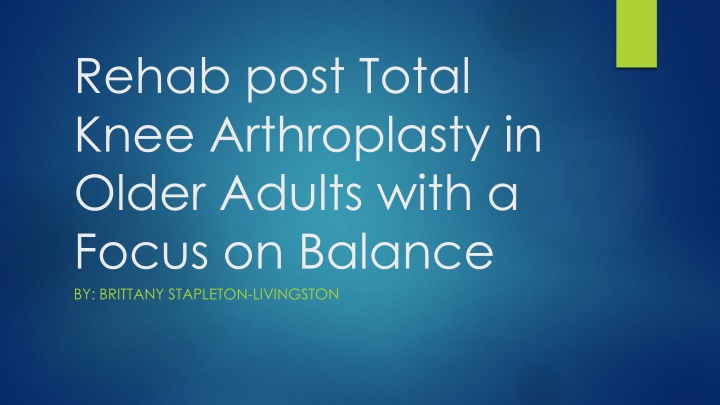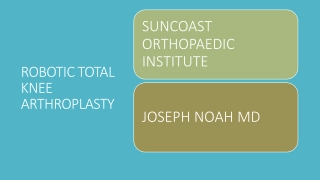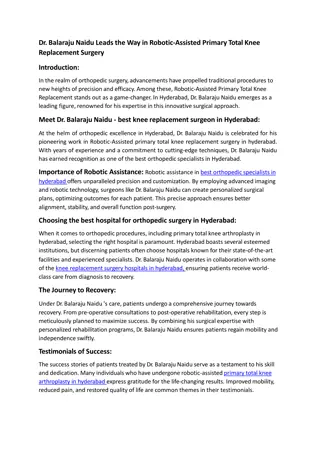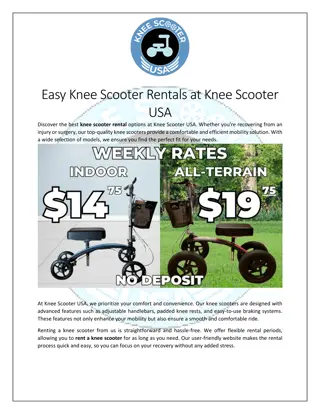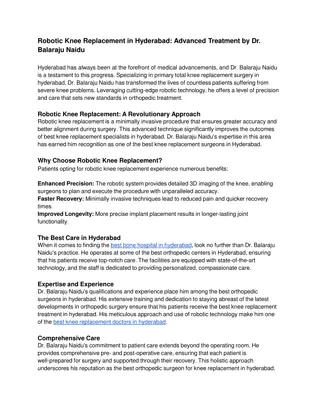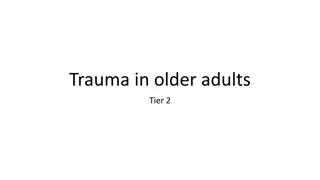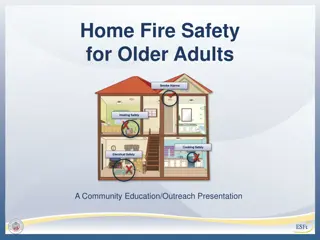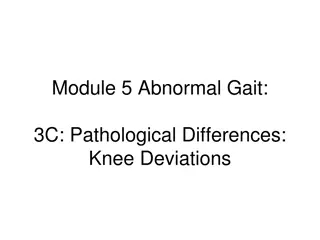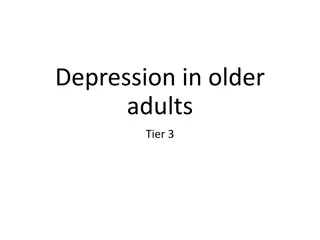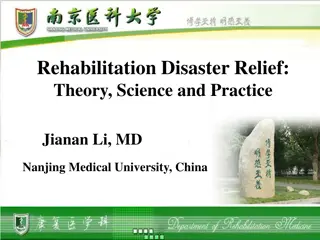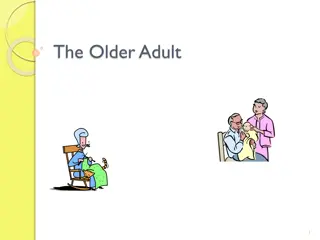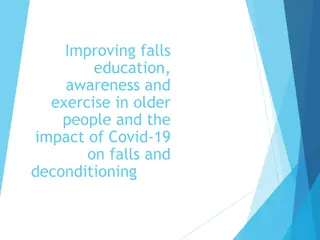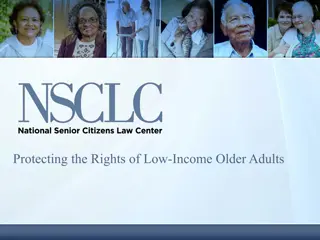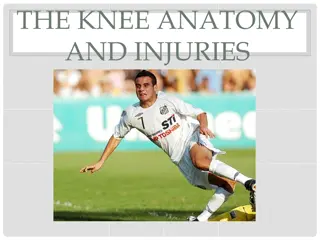Rehab Post Total Knee Arthroplasty in Older Adults with a Focus on Balance
This presentation focuses on the impact of osteoarthritis in older adults, key components of rehabilitation post Total Knee Arthroplasty (TKA), falls risk, evidence-based balance improvement interventions, and the importance of supervision in rehab programs. It discusses the common locations and causes of osteoarthritis, the prevalence and importance of TKA, and basic steps involved in the procedure. The components of post-TKA rehabilitation include strengthening exercises, functional exercises, gait training, and range of motion exercises. Research emphasizes the necessity of supervision for early balance improvements in patients undergoing bilateral TKA.
Download Presentation

Please find below an Image/Link to download the presentation.
The content on the website is provided AS IS for your information and personal use only. It may not be sold, licensed, or shared on other websites without obtaining consent from the author.If you encounter any issues during the download, it is possible that the publisher has removed the file from their server.
You are allowed to download the files provided on this website for personal or commercial use, subject to the condition that they are used lawfully. All files are the property of their respective owners.
The content on the website is provided AS IS for your information and personal use only. It may not be sold, licensed, or shared on other websites without obtaining consent from the author.
E N D
Presentation Transcript
Rehab post Total Knee Arthroplasty in Older Adults with a Focus on Balance BY: BRITTANY STAPLETON-LIVINGSTON
Objectives Learn about the impact of osteoarthritis in older adults. Educate students on the key components of rehab following a Total Knee Arthroplasty (TKA) procedure. Educate students about falls and falls risk in older adults. Identify interventions that are evidence-based for improving balance outcomes in older adults post TKA.
Osteoarthritis Osteoarthritis (OA) is the most common arthritis in older adults. Common locations: Hands, neck, back, knees, and hips Variation in symptoms from person to person Risk of developing OA in older adults is 45% Increases to 57% if the person had a knee injury and 60% if they are obese Causes of OA Older age Sex Obesity Joint injuries Family history Bone deformities
Total Knee Arthroplasty Total Knee Arthroplasty (TKA) is the gold standard for end-stage knee osteoarthritis. Incidence of TKA has increased Prevalence is higher in women 3 million women vs 1.7 million men Number of TKAs performed expected to grow by 673% by 2030
Total Knee Arthroplasty 4 Basic steps Prepare the bone Position the implants Resurface the patella Insert a spacer
Basic Components of Rehab Post TKA There is no universally accepted rehabilitation program for patients after TKA. Strengthening exercises Functional exercises Gait training ROM exercises Exercises specifically for balance may or may not be included in the exercise program.
Supervision Matters Akbaba et al. Single-blind, RCT Investigated the effects of different levels of supervision Group 1=in-home exercise program with supervision from physical therapist 2 days/week; Group 2=same in-home exercise program with supervision from physical therapist 2x/month; Group 3=control group Group 1 had significant improvements in single leg stance, TUG, Stair climbing test, and WOMAC scores at the second month Intensive supervision is required to observe early balance and functional improvements in patients with bilateral TKA
Why is it important to address balance training post TKA?
Falls in Older Adults Falls are common 30% of adults older than 65 years old fall at least once per year Multiple risk factors that predict a fall Cognitive impairments Fear of falling Deficits in balance, strength, vision, and gait Poor medication management Environmental factors Risk of falling increases 3-fold in people with impaired balance or gait
Falls in Older Adults After TKA Swinkels & Allain Investigated the relationship between physical performance tests, self-reported outcomes, and accidental falling before and after TKA 37 patients participated in the study who were randomly selected from a larger study cohort Completed outcome measures before surgery and up to 12 months post surgery Berg Balance Score (BBS), TUG, Hand Grip Strength, Western Ontario and McMaster's Osteoarthritis Index (WOMAC), Activities Balance Confidence Scale (ABC), Geriatric Depression Scale (GDS), and accidental falls Found that 22.7% of the patients fell before and after TKA
Falls in Older Adults After TKA Pandya et al. Found that the falls rate was 45% 1 year post surgery in patients with TKA despite reported pain relief Individuals after TKA with better functional status and reported less difficulties with ADLs had greater balance confidence Mauer et al. Cohort study Investigated the effects of TKA on obstacle avoidance success rate in older adults 29 subjects who had bilateral TKAs, mean age 72 years old; 27 age- matched healthy control subjects, mean range 70 years old Participants with TKAs had a lower obstacle avoidance rate and lower single-leg stance time People with TKA have an increased risk to trip on an obstacle and fall
Deficits in Older Adults After TKA 37% report limited functional improvement one year post surgery Common complaints include decreased walking speed, difficulty with stairs, and unable to return to sport played prior to surgery Patients have deficits in strength, mobility and functional deficits post TKA Stair example Knee joint stability and balance ability are important prognostic factors for falls Impairments in proprioception and postural control continue after surgery
Balance Training After TKA Liao et al. RCT Investigated the effects of additional balance training on mobility and function 58 patients in experimental group, mean age 71 years old; 55 patients in control Experimental group completed conventional functional training plus additional balance exercises The experimental group displayed significant changes in each outcome measures; additional balance exercises improved patient outcomes especially functional recovery and mobility more than traditional functional training
Balance Training After TKA Piva et al. Double-blind, Pilot RCT Evaluated the feasibility of applying a balance exercise program and investigated if a functional training (FT) program supplemented with a balance exercise program could improve physical function compared with an FT program alone 22 patients in control group, 21 patients in experimental group. Mean age 68 years old Experimental group completed functional training program plus balance exercise program Both groups improved lower extremity function; experimental group had greater gait speed, improved single leg stance time, less stiffness.
Balance Exercises Walking Backwards, sideways, on a slope, sideways while crossing the legs, changes in direction Tandem walk Standing on foam Feet together, single leg stance, or catches ball Braiding activities-alternate front and back crossover steps while moving laterally
Balance Exercises continued Tilt board activities Shuttle walking: cones placed at different distances, patient walks to the first cone then walks backward, repeats and walk to the cone that is more distance and repeats Stepping over cones Step-ups
Wii Fit Wii Fit games can serve as an alternative exercise (Fung et al.) 50 patients after TKA participating in outpatient PT Control group: traditional physical therapy session followed by lower extremity strengthening and balance exercises. Experimental group: traditional physical therapy session followed by 15 minutes Wii Fit gaming activities Wii Fit games encouraged lateral weight shifting and multidirectional weight shifting. Examples: tight-rope walk, table tilt, torso twist Outcome measures: length of outpatient rehab, 2-minute walk test, knee ROM, timed standing, activity-specific balance confidence scale, lower extremity functional scale and numeric pain rating scale No significant differences between both groups in any of the outcome measures
Functional Exercises Sit to stands Bilateral knee flexion/extension in standing or squats Ascend and descend a flight of stairs
Strengthening Exercises Isometric knee extension with the knee flexed at 0 degrees with knee flexed at 60 degrees Isometric hamstring with the knee flexed to 60 degrees Straight leg raises Concentric and eccentric strengthening of hip abductors Examples: hip abduction in supine, standing, or side-lying Unilateral knee flexion close to 90 degrees then extension in standing with upper extremity support
Strengthening Exercises continued Leg lifts onto step Knee extension in sitting Resisted knee flexion Form a progressive resistance in later stages of recovery
ROM Exercises Active ROM exercises for the lower extremity Knee flexion exercises Example: heel slides while in bed Knee extension exercises Example: over roll/bar Alternating dorsal and plantarflexion of the ankle Physical therapist assisted knee flexion
Other interventions Stationary cycling Treadmill walking
Conclusion These interventions can be implemented in different settings Acute care: Surgeons may have a particular protocol they want the therapist to follow Example: continuous passive machines Home health: Walking program may be implemented Level of supervision matters
Conclusion There is no standard rehab protocol for patients after TKA Balance exercises should be included to improve functional outcomes and to reduce falls Anytime you start a new exercise you want to be conservative Example: with strengthening exercise you may start with a few repetitions with no weight or use isometrics As patient progresses increase repetitions and/or add resistance It depends on the patient s tolerance and clinical presentation when determining when to progress their program
References Akbaba, Y., Yeldan, I., Guney, N., & Ozdincler, A. (2014). Intensive supervision of rehabilitation programme improves balance and functionality in the short term after bilateral total knee arthroplasty. Knee Surg Sports Traumatol Arthrosc, ISSN 0942-2056 . Foran, J. (2011, December ). Total Knee Replacement. Retrieved from OrthoInfo: http://orthoinfo.aaos.org/topic.cfm?topic=a00389 Fung, V., Ho, A., Shaffer, J., Chung, E., & Gomez, M. (2012). Use of Nintendo Wii Fit the rehabilitation of outpatients following total knee replacement: a preliminary randomised controlled trial. Physiotherapy, 98(3), 183-188. Kurtz, S., Ong, K., Lau, E., Mowat, F., & Halpern, M. (2007). Projections of primary and revision hip and knee arthroplasty in the United States from 2005 to 2030. J Bone Joint Surg Am, 89(4), 780-785. Liao, C., Liou, T., Huang, Y., & Huang, Y. (2013). Effects of balance training on functional outcome after total knee replacement in patients with knee osteoarthritis: a randomized controlled trial. Clin Rehabil, 27(8), 697-709. Lowe, C. M., Barker, K., Dewey, M., & Sackley, C. (2007). Effectiveness of physiotherapy exercise after knee arthroplasty for osteoarthritis: systematic review and meta-analysis of randomised controlled trials. BMJ, 335(7624), 1-9. in
Mauer, A., Draganich, L., Pandya, N., Hofer, J., & Piotrowski, G. (2005). Bilateral total knee arthroplasty increases the propensity to trip on an obstacle. Clin Orthop Relat Res , (433), 160-165. Mayo Clinic. (2015). For Medical Professionals: First nationwide prevalence study of hip and knee arthroplasty. Retrieved from Mayo Clinic: http://www.mayoclinic.org/medical-professionals/clinical-updates/orthopedic- surgery/study-hip-knee-arthroplasty-shows-7-2-million-americans-living-with-implants Mayo Clinic Staff. (2014, October 9). Disease and Conditions Osteoarthritis : Risk Factors . Retrieved from Mayo Clinic: http://www.mayoclinic.org/diseases- conditions/osteoarthritis/basics/risk-factors/con-20014749 Moffet, H., Collet, J., Shapiro, S., Paradis, G., Marquis, F., & Roy, L. (2004). Effectiveness of intensive rehabilitation on functional ability and quality of life after first total knee arthroplasty: a single-blind randomized controlled trial. Archives of Physical Medicine and Rehabilitation, 85(4), 546-556. National Center for Chronic Disease Prevention and Health Promotion. (2014, December 8). Chronic Disease Prevention and Health Promotion: Arthritis. Retrieved from Centers for Disease Control and Prevention and Health Promotion : http://www.cdc.gov/chronicdisease/resources/publications/aag/arthritis.htm National Institute on Aging. (2015, February 23). AgePage: Arthritis Advice . Retrieved from National Institute on Aging: http://www.nia.nih.gov/health/publication/arthritis- advice
Pandya, N., Draganich, L., Mauer, A., Piotrowski, G., & Pottenger, L. (2005). Osteoarthritis of the knees increases the propensity to trip on an obstacle. Clin Orthop Relat Res , (431), 150-156. Pandya, N., Piotrowski, G., Pottenger, L., & Draganich, L. (2007). Pain relief in knee osteoarthritis reduces the propensity to trip on an obstacle . Gait Posture , 25, 106-111. Piva, S., Gil, A., Almeida, G., DiGioia, A., Levison, T., & Fitzgerald, G. (2010). A balance exercise program appears to improve function for patients with total knee arthroplasty: a randomized clinical trial. Phys Ther, 90(6), 880-894. Pozzi, F., Snyder-Mackler, L., & Zeni, J. (2013). Physical exercise after knee arthroplasty: a systematic review of controlled trials. Eur J Phys Rehabil Med, 49(6), 877-862. Pua, Y.-H., Clark, R., & Ong, P.-H. (2015). Evaluation of the Wii Balance Board for walking aids prediction: proof-of-concept study in total knee arthroplasty. PLOS, 10(1), 1-11. Swinkels, A., & Allain, T. (2013). Physical performance tests, self-reported outcomes, and accidental falls before and after total knee arthroplasty: an exploratory study. Physiother Theory Pract, 29(6), 432-442. Webster, K., Feller, J., & Wittwer, J. (2006). Balance confidence and function after knee-replacement surgery. J Aging Phys Act, 14(2), 181-191.
